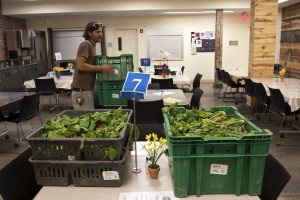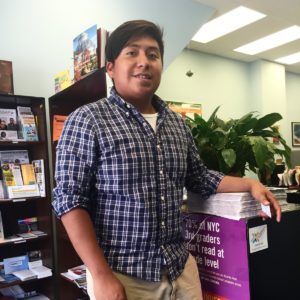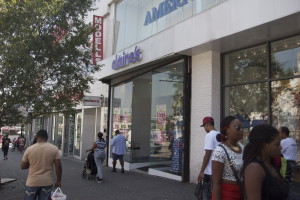On most days, Dagger John’s restaurant at Fordham University earns its reputation as the most popular on-campus eating place. Students gather in the spacious dining area with music playing in the background.
But on Sept. 27, the music disappeared and half of the tables were taken over by baskets of vegetables and food scales. Half a dozen people gathered around each table, checking out and selecting vegetables and there was a line of customers extending out the door.
The interloper is officially called the St. Rose’s Garden Community Supported Agriculture Market. It is a cooperative vegetable buying club that invests in Norwich Meadows Farm in upstate Norwich, N.Y. The founder is Jason Aloisio, 27, an ecology Ph.D. student at Fordham, who is also the founder of an on-campus farm, St. Rose’s Garden.

Aloisio also works at the education center at Prospect Park Zoo, connecting teenagers with nature. (YI DU/The Bronx Ink)
“I love eating good food,” said Aloisio, “and I want people to connect to the nature through food. I want them to put their hands in soil, to see what food look like originally.”
Aloisio sees St. Rose’s Garden and the co-op farmer’s market as ways to help make diets healthier in the Fordham community and even the Bronx at large.
People can buy cheap organic vegetables, including tomato, parsley, radish, soybean, turnip, pepper, carrot and garlic grown in St. Rose’s Garden, or they can join the co-op and receive different fresh vegetables every Thursday from Norwich Meadows.
St. Rose’s Garden is believed to be the only on-campus garden in the Bronx; the only other on-campus farmers’ market is at Albert Einstein College of Medicine.
Growing up in Shoreham on Long Island, Aloisio learned to eat healthy food. As a child, his father, a dentist, kept no candy or desert at home. Fast or processed food was also rare in his home.
“We always had cooked food,” Aloisio said, “so I grew up with real good food.”
Throughout his four years at Fordham, Aloisio has brought that sensibility to the Bronx. When he’s not fulfilling his teaching responsibilities as a Ph.D. candidate, he spends his time on the rooftop of the university parking garage, which he considers his private lab. His dissertation is about “green roofs” in urban areas.
St. Rose’s Garden was originally a piece of unused land that university officials gave to Aloisio to grow edible plants like tomatoes and pumpkins in order to demonstrate new uses for wasted spaces. But he decided instead to use the 1,500-square-foot area to build an on-campus community farm for the whole school.
Aloisio first had this idea of creating a garden on the grounds last year, but wasn’t able to recruit enough volunteers.
This year, Aloisio prepared a formal proposal to change the abandoned land in the unused corner of the school near faculty parking garage into a community garden. He also went to different academic departments, trying to get at least $1,750 to buy essential materials for the garden.
The proposal earned Aloisio a little more than the minimum from three deans at Fordham University who also volunteered in the garden’s construction.
In April, Aloisio and Elizabeth Anderson, an undergraduate student studying environmental policy, started advertising for more volunteers through blogs and by sending emails to students.
On April 23, more than 50 volunteers, including students and faculty members, showed up to assist Aloisio and Anderson building the garden. They removed weeds, built eight raised beds covering 244 square feet and bought 20 cubic yards of soil to fill them. They also laid a water system and planted seeds that blossomed into rows of eggplants, green beans, green and red peppers, cucumbers, lettuce, tomatoes, pumpkins and basil.

St. Rose’s Garden is now producing more than 10 kinds of vegetables. (YI DU/The Bronx Ink)
St. Rose’s Garden offered up its first harvest in September. Green leafy vegetables poked out of their beds. Eggplants turned purple and hid under big leaves. Pumpkins were still in the yellow flower phase, quietly waiting their turn to ripen into fruit.
The garden has also helped grow other efforts at Fordham.
John van Buren, the director of Environmental Policy Program who serves as the faculty advisor for St. Rose’s Garden, is including eight hours of volunteer work at the garden as part of his class.
“Aside from providing fresh, organic vegetables, and an opportunity for playing in the dirt,” said Aloisio, “the underlying mission of St. Rose’s Garden is to be an educational catalyst, both in the classroom and in social settings, for discussion about the broken food system and coupled human-ecosystem interactions.”
He seems to be reaching that goal. “He (Aloisio) is very outgoing, a good person to get things going,” said Joe Hartnett, a junior biology student in the environmental policy class who was one of the volunteers. “He always makes things clear. He is a really good teacher.”
Aloisio was Hartnett’s assistant teacher when he was a freshman. Hartnett said Aloisio brought a lot of different ideas to their environmental classes, making their studies fun and easy to understand. “He is very vocal and energetic,” said Hartnett. “In his email to me, he would say something like ‘Yes, Joe. You CAN do this!’ ”
“He is so passionate,” said Samir Hafez, an economics and environmental policy graduate student. “I admire him for his energies. He never gets discouraged.”
Aloisio says the food co-op is another important component of his campaign to encourage healthy eating.
Consumers pay $16 per week to get a share of six to eight pounds of vegetables and fruit. They agree to buy produce from the farmers for 10 weeks. The vegetables are delivered to Dagger John’s every Thursday for less money than in the supermarket because there is no middleman.
Consumers don’t know what they will get for the week; it depends on what’s available. All the vegetables are picked less than two days before the market.
Katie Buckle, a sophomore at the Gabelli School of Business, did some math with her two roommates. They realized that it would only cost about $5 per person to receive more than enough healthy fruit and vegetables so the three of them decided to pool their money and buy a share together.
“The local farmers send whatever produce they have freshly harvested that week, so our weekly bounty will change and we will likely receive new fruit and vegetables we’ve never tried before,” said Buckle. “To me, this element of surprise is the best part.”
There are currently 137 shares of the co-op, more than Aloisio expected. “We were aiming for 50, and we got 137!” said Aloisio. “I was a little overwhelmed.”
Three resident assistants bought some shares to set up a little farmers’ market in their dorms.
“It helps me to keep a healthier diet,” said Jordan Higgins, a senior biology student. Higgins said she had to Google how to cook much of the produce, but it made her eat more vegetables.
Norwich Meadows Farm also provides vegetables to students at Fordham’s Lincoln Center campus.
Both the co-op and St. Rose’s Garden share space at Dagger John’s. The student-run farmers market allows people who didn’t buy a share in the co-op the opportunity to enjoy fresh vegetables.
John Craven, a Fordham business professor, was one recent satisfied customer. “This is the best baby carrot I have ever had,” he said as he sampled a small fresh carrot grown in St. Rose’s Garden. He did not even scrub off the mud before he ate a second one.
Money earned by selling produce from St. Rose’s Garden goes to the daily maintenance of the garden.
“This is really not for profit,” said Aloisio. “We just want to get the food to people.”
The first day of the two markets was especially long for Aloisio. More than 200 people stopped by. Even though there were three volunteers helping him, Aloisio still had to answer all the questions about the food and the garden, organize containers and refill vegetables, and find bags for those who forgot to bring one.

St. Rose’s Garden has donated a total of more than $1,000 worth of vegetables to Part of the Solution since the first day of the farmer’s market. (YI DU/The Bronx Ink)
Four full containers of vegetables were left after the first day. Aloisio and his volunteers donated all the vegetables to a local non-profit group called Part of the Solution. These vegetables are repacked in Part of the Solution’s food pantry.
Aloisio would like to have more efforts in the Bronx beyond Fordham. Statistics from the Department of Health show that only 6.3 percent of Bronx residents eat the recommended five daily servings of fruit or vegetables.“I hope to get more people involved,” he said, “Maybe refugees in the Bronx can come and work in the garden. Or maybe make it a refugee garden or a asylum garden.”
At the moment, however, it’s hard for people outside of the Fordham community to benefit from the garden. Visitors have to show a valid ID and pass a security guard to get on campus.
In the meantime, Aloisio is focused on keeping St. Rose’s Garden working smoothly.
All volunteers work on a weekly basis now. But as the mid-term approaches, a lot of students are too busy to help. Aloisio dedicates most of his time to the garden.
“I have free time, somewhere, not really,” said Aloisio, as he dropped off four containers of vegetables at Part of the Solution — alone.
















